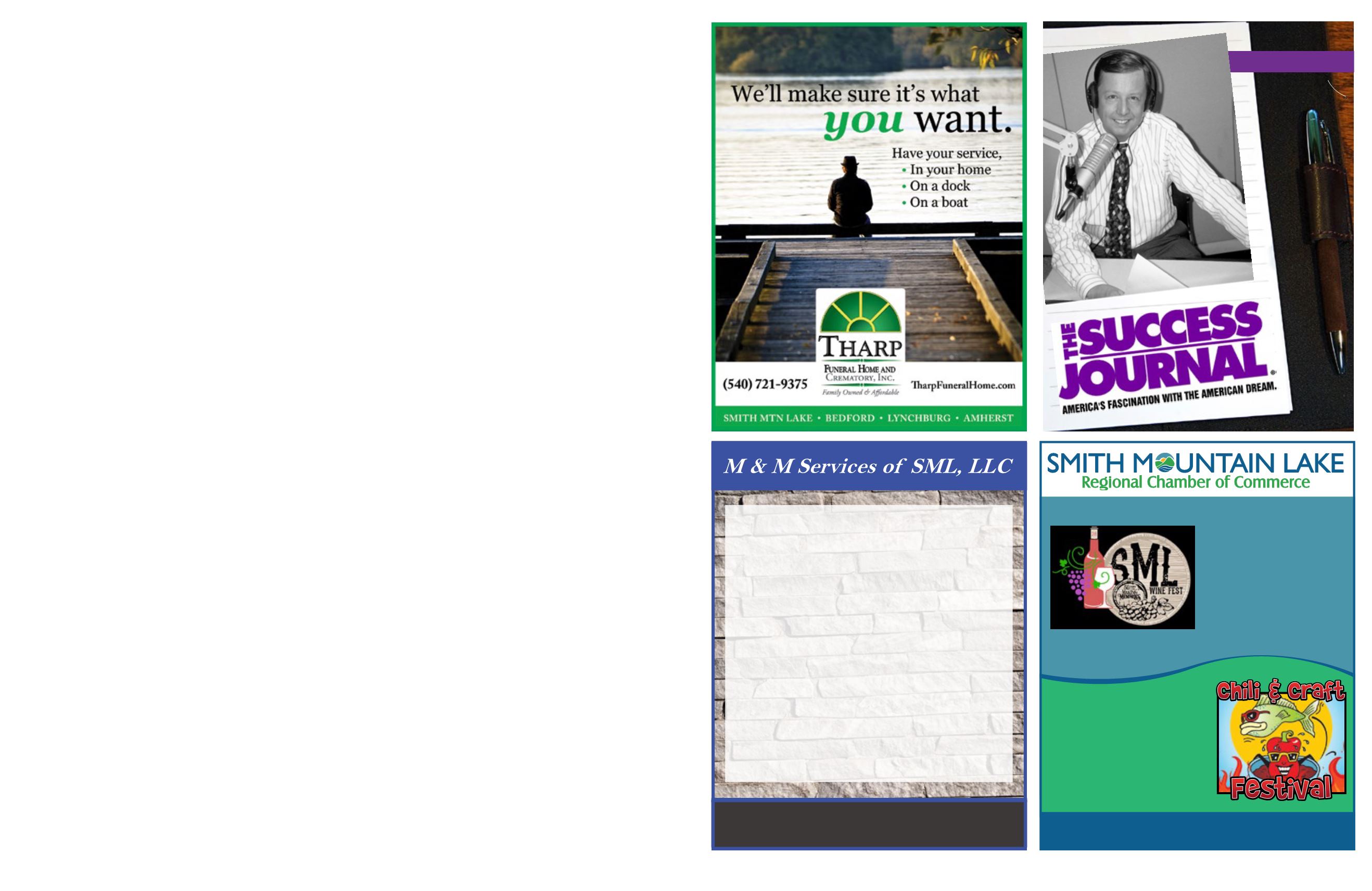
Discover Smith Mountain Lake
FALL 2016
17
16
The first “undertakers”, he says, were actually cabinetmakers
“who made caskets on the side.” They came to be called
undertakers because they “undertook” the death care that
formerly only family members had performed. Once these
“cabinet makers” began selling and delivering caskets, it was
only a matter of time before they also started transporting
bodies from the home to the cemetery, and then making and
selling markers for graves.
It was shortly before the Civil War broke out that Thomas
Holmes, a medical surgeon, invented a satisfactory and safe
embalming fluid. Prior to his research and development,
several medical students had died as the result of routine
dissections of cadavers that had been preserved with
poisonous chemicals, which was the only effective
embalming fluid available prior to Holmes’ discovery.
“Embalming took off during the Civil War,” Chris says.
“Wealthy (Confederate) families made arrangements with
battlefield embalmers to keep track of their sons. If they
were killed, their body was embalmed right in the field
and sent back home to the family for burial in the family
cemetery.”
These freelance undertakers were given safe passage
between the lines, thus allowing them to ply their trades in
Richmond as well as DC.
It was a standard rule, at least several months into the
war, that all Union troops were to be embalmed, and their
remains sent home on trains in caskets that were sometimes
lined with zinc. The deceased’s name was on the lid, along
with the home address of the spouse or parents. Personal
effects and papers were placed in the box along with the
body.
Within days after the war ended, President Lincoln was shot
and killed. His embalmed body was put on display in 20 or
more cities, and viewed by hundreds of thousands as it was
moved by train from DC to Springfield, Illinois over a two-
week period. Seeing howwell his body was preserved helped
to make the embalming process acceptable to the American
public. It also became a practical way to give relatives time
to travel and gather for a funeral.Without embalming, it is
necessary to bury a person’s remains within two days, due
to the rapid decomposition of a human body. Demand for
Holmes’ embalming fluid soon became widespread, being
sold to surgeons, anatomists and undertakers.
Instructors who represented chemical companies began
offering courses and awarding diplomas in embalming.
In time, many of these companies established mortuary
schools.As embalming became more popular, so did funeral
homes. By 1920, there were 24,469 funeral homes in the
US.
Chris remembers his grandfather, who joined the Bedford
business in 1931, telling about “bathtub embalming” for
“home funerals”. In most other cases, the body would be
removed from the private home within a two-day period,
and taken to the funeral home where there were facilities
for embalming. From the funeral home, it was either taken
back to the family home or to the cemetery, first in a horse-
drawn hearse, and later in a motorized hearse.
With the advent of the automobile, it was only a matter
of time until the local funeral home’s hearse doubled as
an ambulance. Hearses were, after all, the only enclosed
vehicles that were large enough and comfortable enough to
transport bodies that were too sick or injured to sit upright.
Many of us today remember seeing the local hearse with
a portable flashing red light on its roof, doubling it as an
ambulance.
“By 1960, people were becoming more secular, and
less involved with a particular church,” Chris says, so his
grandfather added a large chapel to the family-owned
structure. Now, every detail of death care could be provided,
even a place for final prayers.
The 20th Century mortician thus had become a funeral
director in every sense. The burden of death care had
been completely lifted from grieving loved ones, and was
performed by the mortician or a staff member at the funeral
home. Chris’s grandfather added the chapel in response to
changing customs and, for the same reason, Chris’s father
installed a crematorium in 1983.
“He got hate mail,” Chris recalls. In those early days not
many chose cremation. Some churches even forbade the
practice. Today, he says, 56 percent of his clientele, which
includes the Bedford area and about half of Smith Mountain
Lake, favor cremation.
“Many people are having cremation performed immediately
WITH CHRIS WITTING
Weekdays at 12:10 PM
WSLK
Lake Radio 880
For more information, call
540-721-1203
or
NEW Location!
Crazy Horse Campground
Bridgewater Plaza
Children 12 and Under FREE • Rain or Shine
Limited Parking, Carpooling Encouraged
No Refunds • No Pets Allowed
No Outside Alcohol Allowed
Limited Designated Tent Area
• Crafts • Chili Cook-o Competition
• Trophies for “Best Chili”“People’s Choice”
“Showmanship” • Admission is $5
For advance tickets & info:
For more info, contact the SML Visitor’s o ce:
540.721.1203
Saturday, Sept. 24th, 2016
11 a.m. - 6p.m.
Sunday, Sept. 25th, 2016
11 a.m. - 5p.m.
Saturday, November 5, 2016
11a.m.- 3:30p.m.
Chi l i & Craft
Festival
Email us at
Call Us! (540)309-6375
or visit us on facebook/MandMServices4
HATE TO DIY?
Handyman Services
Cleaning Services
Yard Maintenance
Grocery Shopping
Boat Cleaning
Pig Roasts
Window Wash
& anything else you HATE to do yourself!


